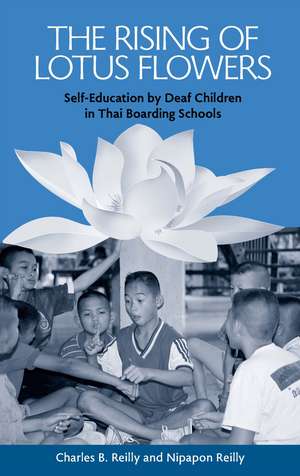The Rising of Lotus Flowers: Self-Education by Deaf Children in Thai Boarding Schools: Sociolinguistics in Deaf Communities, cartea 11
Autor Charles B. Reilly, Nipapon Reillyen Limba Engleză Hardback – 14 noi 2005
In developed nations around the world, residential schools for deaf students are giving way to the trend of inclusion in regular classrooms. Nonetheless, deaf education continues to lag as the students struggle to communicate. In the Bua School in Thailand, however, 400 residential deaf students ranging in age from 6 to 19 have met with great success in teaching each other Thai Sign Language (TSL) and a world of knowledge once thought to be lost to them. The Rising of Lotus Flowers: Self-Education by Deaf Children in Thai Boarding Schools reveals how their institutionalization allowed them to foster a unique incubator of communication and education.
Charles B. Reilly, a teacher and community organizer in Thailand for eight years, and Nipapon Reilly, a Deaf Thai citizen, studied the students in the Bua School for 14 years, with periodic follow-ups thereafter. They found that the students learned little from their formal instructors, but that they were able to educate each other in time spent away from the classroom. Older students who had learned TSL in the dorms and on the playground successfully passed it on to six-year-olds who had virtually no language at all. The Reillys’ study uncovers an elaborate hierarchy of education among these students, with each group using games and other activities to teach and bring other classmates up to their level. Named for the much admired aquatic plant that blooms in Thailand’s bogs, the Bua School epitomizes the ideal of The Rising of Lotus Flowers, which also offers analytical evidence of the continuing value of residential schools in deaf education.
Charles B. Reilly, a teacher and community organizer in Thailand for eight years, and Nipapon Reilly, a Deaf Thai citizen, studied the students in the Bua School for 14 years, with periodic follow-ups thereafter. They found that the students learned little from their formal instructors, but that they were able to educate each other in time spent away from the classroom. Older students who had learned TSL in the dorms and on the playground successfully passed it on to six-year-olds who had virtually no language at all. The Reillys’ study uncovers an elaborate hierarchy of education among these students, with each group using games and other activities to teach and bring other classmates up to their level. Named for the much admired aquatic plant that blooms in Thailand’s bogs, the Bua School epitomizes the ideal of The Rising of Lotus Flowers, which also offers analytical evidence of the continuing value of residential schools in deaf education.
Preț: 327.11 lei
Preț vechi: 380.74 lei
-14% Nou
Puncte Express: 491
Preț estimativ în valută:
62.61€ • 68.03$ • 52.63£
62.61€ • 68.03$ • 52.63£
Carte indisponibilă temporar
Doresc să fiu notificat când acest titlu va fi disponibil:
Se trimite...
Preluare comenzi: 021 569.72.76
Specificații
ISBN-13: 9781563682759
ISBN-10: 1563682753
Pagini: 272
Dimensiuni: 152 x 229 x 23 mm
Greutate: 0.59 kg
Ediția:First Edition
Editura: Gallaudet University Press
Colecția Gallaudet University Press
Seria Sociolinguistics in Deaf Communities
ISBN-10: 1563682753
Pagini: 272
Dimensiuni: 152 x 229 x 23 mm
Greutate: 0.59 kg
Ediția:First Edition
Editura: Gallaudet University Press
Colecția Gallaudet University Press
Seria Sociolinguistics in Deaf Communities
Notă biografică
Charles B. Reilly is a researcher in the Gallaudet Research Institute and the director of Gallaudet’s community development project in Thailand.
Nipapon Reilly is an artist and assistant teacher at the Laurent Clerc National Deaf Education Center.
Nipapon Reilly is an artist and assistant teacher at the Laurent Clerc National Deaf Education Center.
Recenzii
"Provides insight into the process of language acquisition in deaf communities within a context of social interaction in a cross-cultural educational setting."
Descriere
Offers analytical evidence for the continuing value of residential schools in deaf education.













